![[SIHH2012] Greubel Forsey GMT](https://www.watchonista.com/sites/default/files/styles/1140x0/public/watchographer/2914/articles/149473/front/sihh2012_greubel_forsey__gmt_8_rectangle.jpg?itok=9uGJvX8G×tamp=1507896766)
![[SIHH2012] Greubel Forsey GMT](https://www.watchonista.com/sites/default/files/styles/1140x0/public/watchographer/2914/articles/149473/front/sihh2012_greubel_forsey__gmt_8_rectangle.jpg?itok=9uGJvX8G×tamp=1507896766)
The GMT, the first true Greubel Forsey with complications?
Stricto Sensu, a large Power reserve or a tourbillon are not complications.
Complications are defined as extra functions, not as improvements of the HMS functionalities.
Besides a flimsy power reserve and in spite of a superlative work of builders, Steven Forsey and Robert Greubel had never added complications to their horologic cathedrals. Even a quadruple or double technical tourbillons did not bring any extra functionality, despite their outstanding accuracy (CF the victory at the Chronometry contest).
This GMT, summarily named, discloses a complexity whose plumage’s interest is inversely proportional to the sobriety of its song.
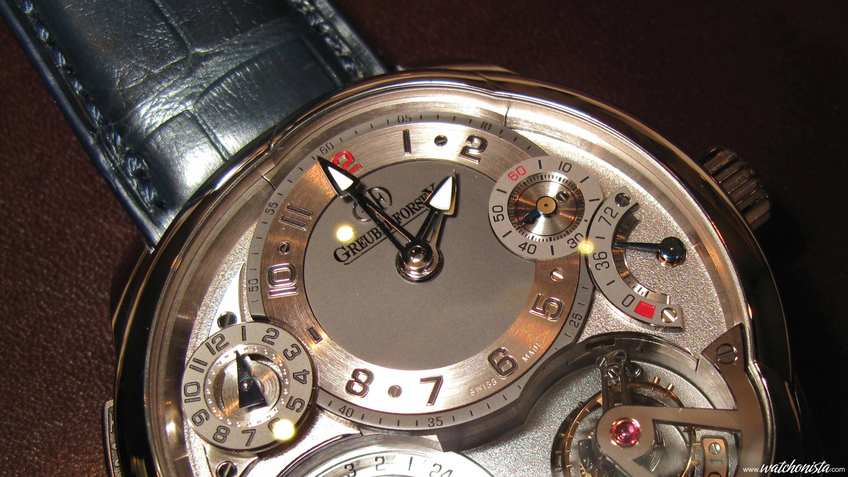
The watch is the next step in the work of three-dimensionality that Greubel-Forsey has been pursuing until now.
While the classic elegance tends toward super-flat cases, GF always presented very thick watches, totally against the trends. GF’s quest for accuracy via inclined toubillons significantly impacted the thickness of the watchcases.
Internally, the main discussions must have focused on how to make an optimal use of these volumes, almost never before seen in watchmaking.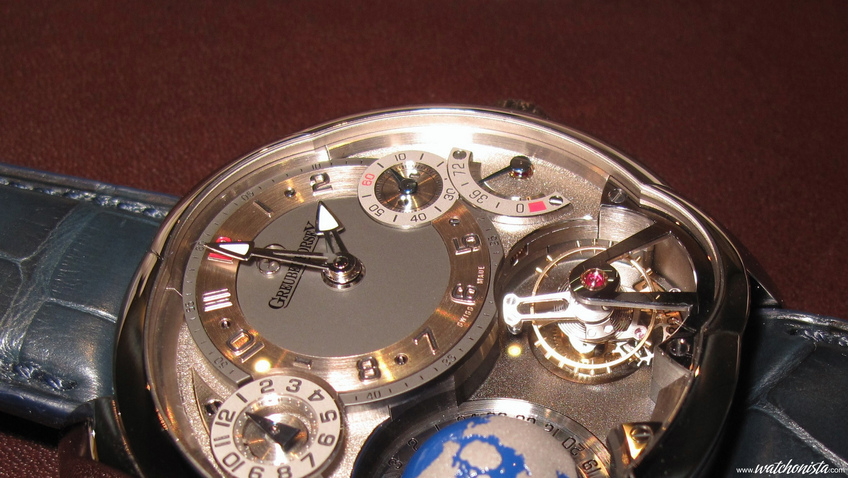
Digression: Maybe GF should comprehensively overhaul their design (as it has been the case for “Histoire de Tourbillon 3”, a watch produced by Harry Winston together with GF’s design office, Complitime).
Because the classic circular watchcases are offbeat compared to the iconoclast design of the movement from GF.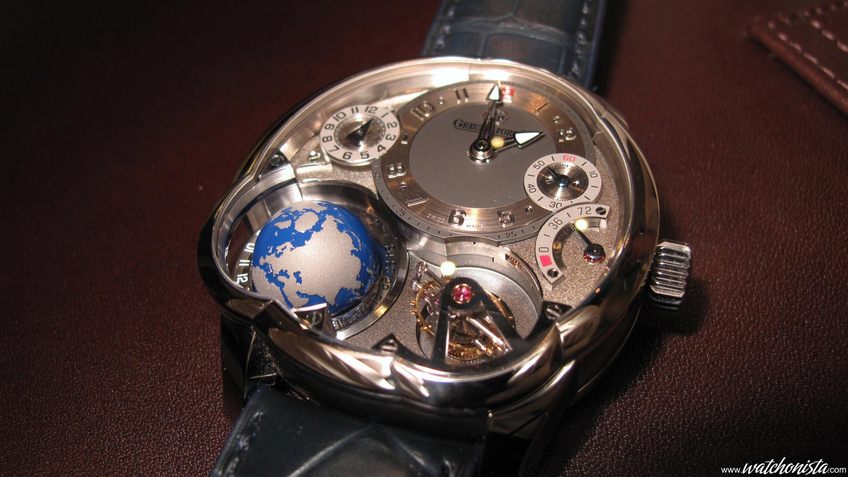
Hence, in order to speed things up, GF had to exploit their outstanding talent for tridimensional designs into their new creations.
It paid off with this GMT, which sports a gigantic globe made of electroplated titanium.
Now, of course, the electroplating is not really glamorous. However, to compare the plating performed on this map of the World to a chemistry class, is akin to comparing the work of a micro-surgeon to that of a veterinarian.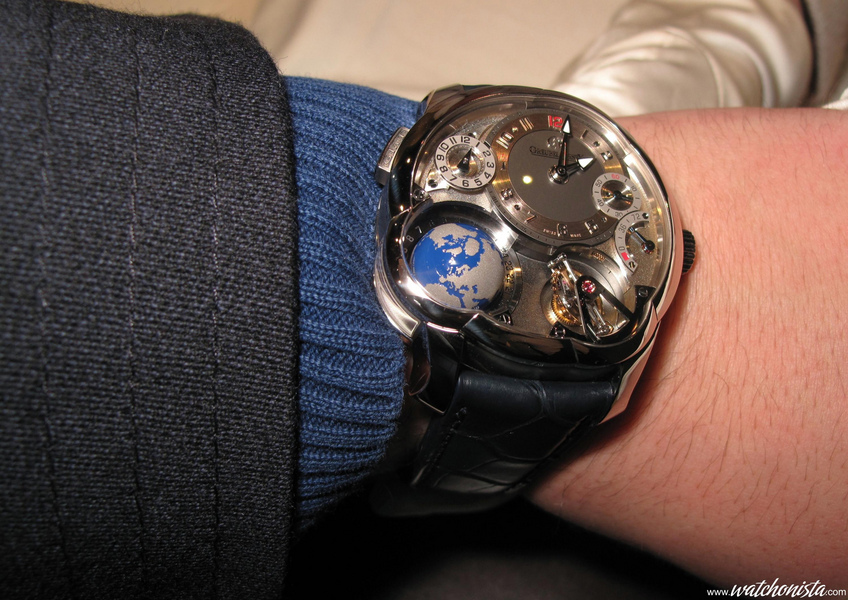
The globe (13mm diameter) was engraved with precision drills, while the continents were covered with a protective coating. Then, the exposed areas, aka the oceans, were attacked with acid. These parts were then coated with several electroplated layers, in order to produce these magnificent lacquered blue oceans.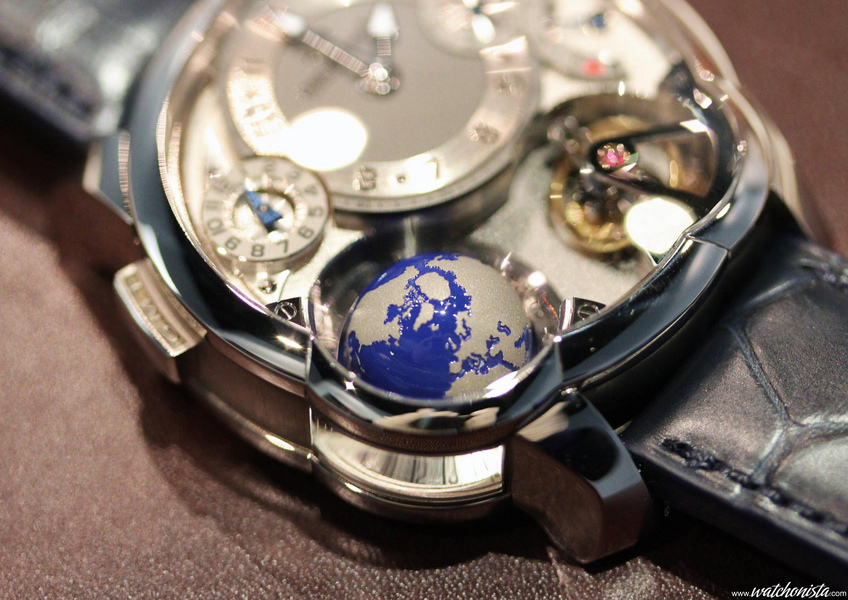
An approchant technic used in this tourbillon 24sec, rememeber also the HW Opus VI: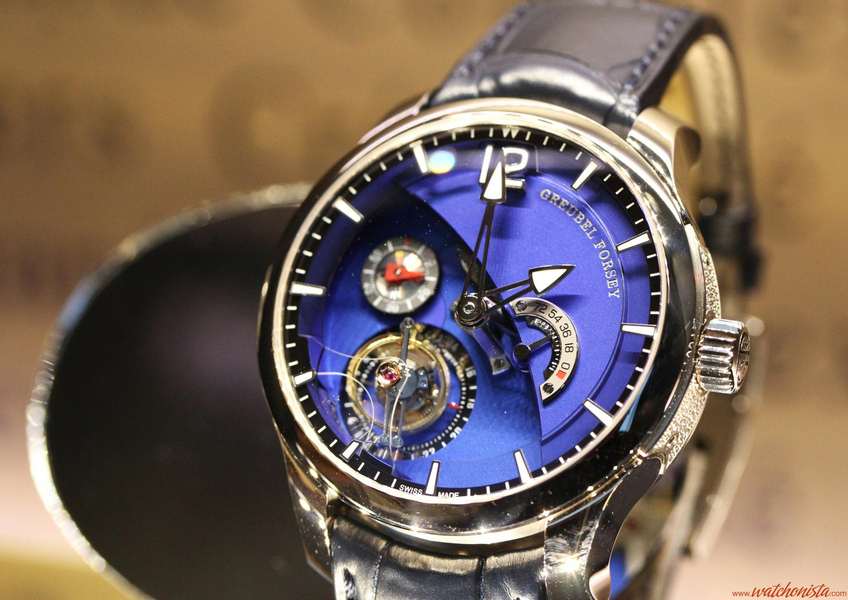
This mini earth fitted on an axis at its south pole, accomplishes a counter-clockwise rotation in 24 hours, like our planet.
The pusher located at 11 o’clock enables the advancement of the time zone also displayed at 11 o’clock, whereas the disk sitting on the case back displays the 24 zones, as well as the summer and winter times.
The cities in black don’t have summer time, contrary to the white ones.
The summer time is featured on the central ring, while the «standard » time sits on the peripheral one.
This device indisputably takes time to get used to, which should not be a problem for the lucky owners of this beauty.
As per its layout, the disk is somewhat a reminder of the Pirata GMT from Cuervos y Sobrinos, and more than many GMT watches, this piece is an invitation to travel.
Who, here, and without searching on Gogol, knows of Astana, Apia or F. de Noronha ?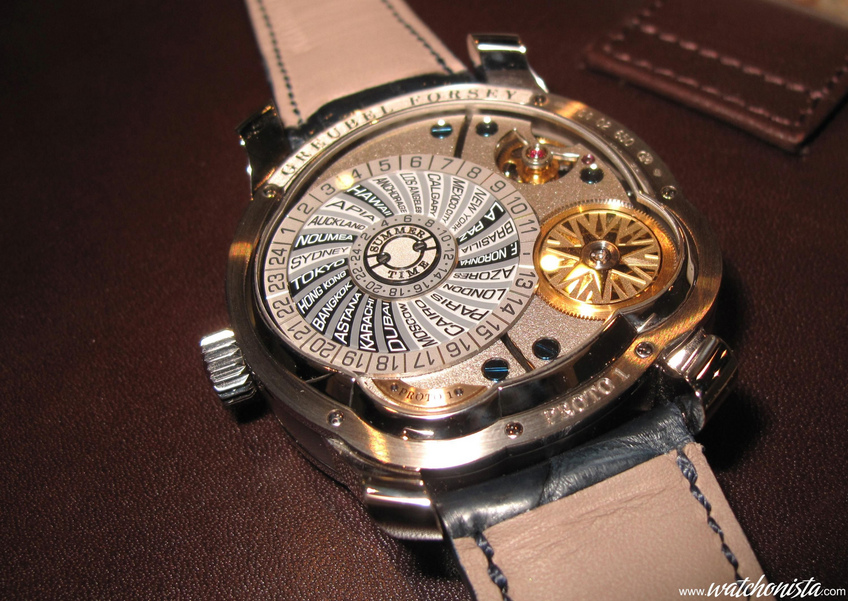
More than ever, the overall design utilizes concentric circles; this device, akin to a planetary gear, features the earth at the pinnacle, of course. The Power reserve indicator sits at 3 PM, the second time zone at 10 o’clock and the universal time of course displayed between 6 and 8 o’clock, indicated by the globe’s rotation. The watchcase measures 43.5 by 16mm, but it is bulkier than Luminor 44mm, as, because of its aperture and its thickness, it appears to be 45mm. Indeed, this watch is not intended for lovers of refined extra-thin pieces, and moreover, the twisting of the 25° inclined tourbillon and its very fast 24 sec. rotation reminds us of dreams turned to reality.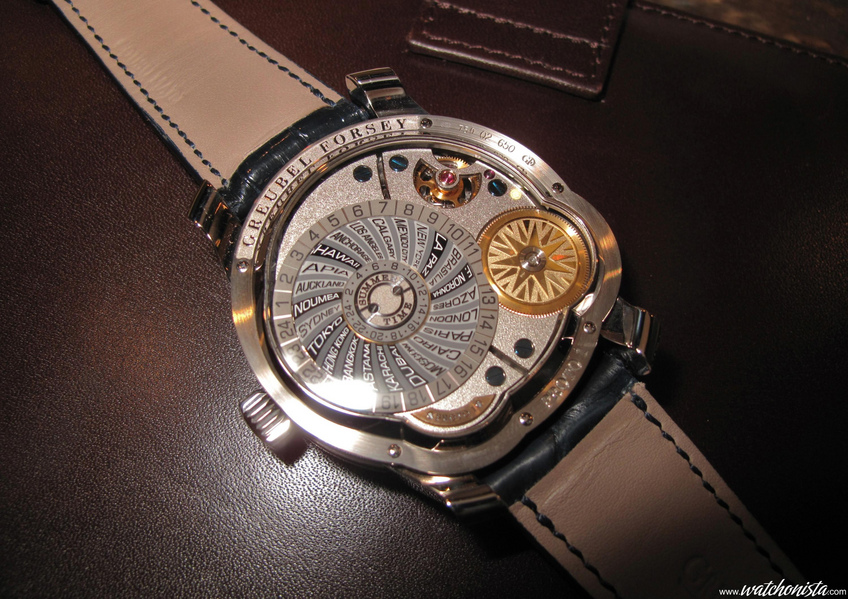
Digression: Like most of the productions by GF, the watchcase features an aperture on one side, which allows the globe to be visible through a transparent sapphire.
Now, let’s imagine that the globe is covered dial wise by a polarized glass, which would let the light out but not in; the light would only come in sideways, and therefore the globe would be lit in the same way the sunrays illuminate the Earth.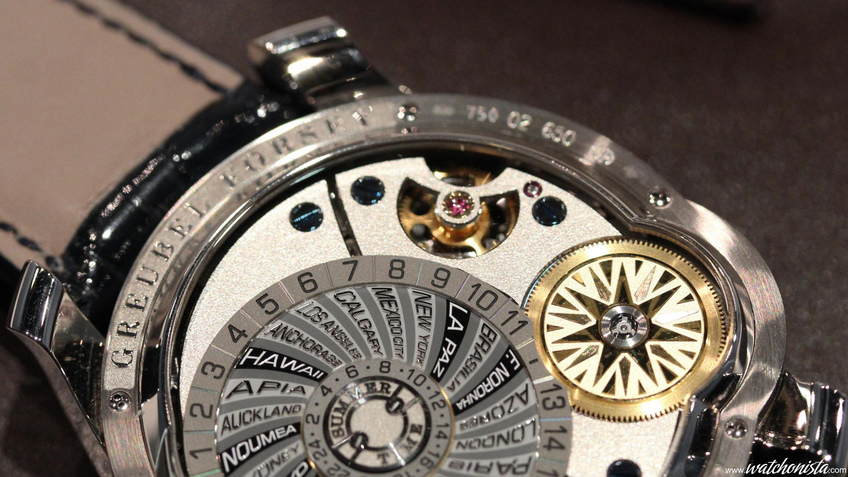
The only serious flaw of this watch is its price, about half a million Euros, knowing that it competes with many other dream watches, very fine collector’s pieces, as well as with the very top of the line of the watchmaking industry. Collectors will judge by themselves.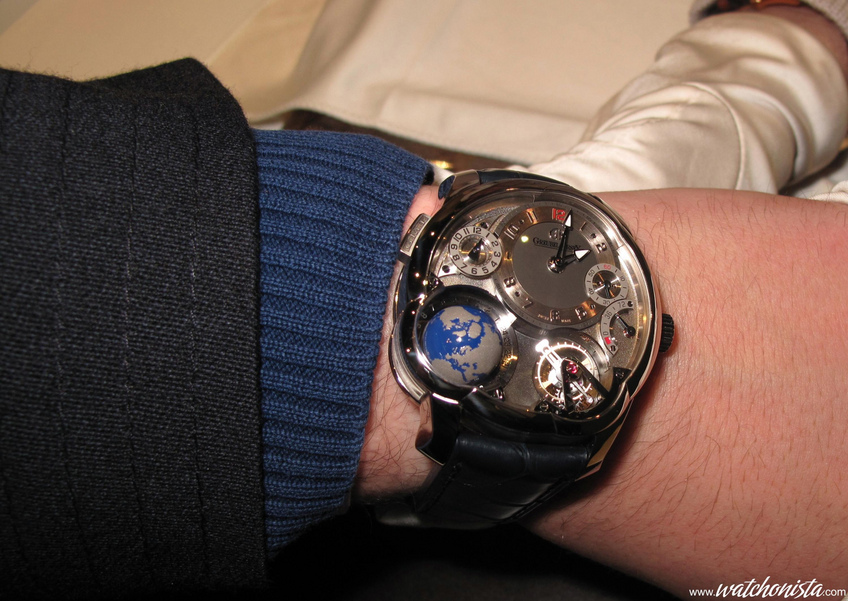
When one cannot further increase the surface area, one increases the volume, like buildings (especially those in New York, whose design is one of the main sources of inspiration for watchmakers).
In their quest for renewal , the independent watchmakers, from MB&F to Greubel-Forsey through Hautlence, have shaken-up the designs of complications and displays by adding height as an extra dimension.
With this GMT, their first watch with complication, tridimensional, GF reaches a turning point in its evolution, at least as important as it did with the Invention 1; without disavowing the initial concept, they could create new standards in watchmaking, if the traditional complications like chronographs or calendars, were reinterpreted in a new dimension.
